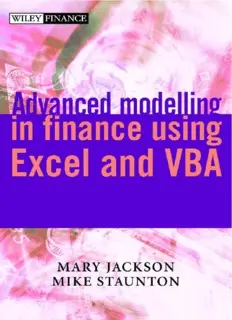
FINANCE Advanced modelling in finance using Excel and VBA 0471499226 PDF
Preview FINANCE Advanced modelling in finance using Excel and VBA 0471499226
Advanced Modelling in Finance using Excel and VBA Wiley Finance Series OperationalRisk:MeasurementandModelling Jack King AdvanceCreditRiskAnalysis:FinancialApproachesandMathematicalModelstoAssess,Priceand ManageCreditRisk DidierCossin and Hugues Pirotte DictionaryofFinancialEngineering John F. Marshall PricingFinancialDerivatives:TheFiniteDifferenceMethod Domingo A Tavella and Curt Randall InterestRateModelling Jessica James and Nick Webber Handbook of Hybrid Instruments: Convertible Bonds, Preferred Shares, Lyons, ELKS, DECS and OtherMandatoryConvertibleNotes Izzy Nelken (ed) OptionsonForeignExchange,RevisedEdition David F DeRosa TheHandbookofEquityDerivatives,RevisedEdition Jack Francis, WilliamToy and J Gregg Whittaker VolatilityandCorrelationinthePricingofEquity,FXandInterest-RateOptions Riccardo Rebonato RiskManagementandAnalysisvol.1:MeasuringandModellingFinancialRisk Carol Alexander (ed) RiskManagementandAnalysisvol.2:NewMarketsandProducts Carol Alexander (ed) ImplementingValueatRisk Philip Best CreditDerivatives:AGuidetoInstrumentsandApplications Janet Tavakoli ImplementingDerivativesModels Les Clewlow and Chris Strickland Interest-RateOptionModels:Understanding,AnalysingandUsingModelsforExoticInterest-Rate Options(secondedition) Riccardo Rebonato Advanced Modelling in Finance using Excel and VBA Mary Jackson and Mike Staunton JOHN WILEY & SONS, LTD Chichester ž New York ž Weinheim ž Brisbane ž Singapore ž Toronto Copyright2001byJohnWiley&Sons,Ltd, BaffinsLane,Chichester, WestSussexPO191UD,England National 01243779777 International(C44)1243779777 e-mail(forordersandcustomerserviceenquiries):[email protected] VisitourHomePageonhttp://www.wiley.co.uk orhttp://www.wiley.com AllRightsReserved.Nopartofthispublicationmaybereproduced,storedinaretrieval system,ortransmitted,inanyformorbyanymeans,electronic,mechanical,photocopying, recording,scanningorotherwise,exceptunderthetermsoftheCopyright,DesignsandPatentsAct 1988orunderthetermsofalicenceissuedbytheCopyrightLicensingAgency,90TottenhamCourt Road,LondonW1P9HE,UK,withoutthepermissioninwritingofthepublisher. OtherWileyEditorialOffices JohnWiley&Sons,Inc.,605ThirdAvenue, NewYork,NY10158-0012,USA Wiley-VCHVerlagGmbH,Pappelallee3, D-69469Weinheim,Germany JohnWiley&SonsAustraliaLtd,42McDougallStreet,Milton, Queensland4064,Australia JohnWiley&Sons(Asia)PteLtd,2ClementiLoop#02-01, JinXingDistripark,Singapore129809 JohnWiley&SonsCanadaLtd,6045FreemontBlvd, Mississauga,ONT,L5R4J3,Canada BritishLibraryCataloguinginPublicationData AcataloguerecordforthisbookisavailablefromtheBritishLibrary ISBN0471499226 Typesetin10/12ptTimesbyLaserwordsPrivateLimited,Chennai,India PrintedandboundinGreatBritainbyBookcraft(Bath)Ltd,Midsomer–Norton Thisbookisprintedonacid-freepaperresponsiblymanufacturedfromsustainableforestry, inwhichatleasttwotreesareplantedforeachoneusedforpaperproduction. Contents Preface xi Acknowledgements xii 1 Introduction 1 1.1 Finance insights 1 1.2 Asset price assumptions 2 1.3 Mathematical and statistical problems 2 1.4 Numerical methods 2 1.5 Excel solutions 3 1.6 Topics covered 3 1.7 Related Excel workbooks 5 1.8 Comments and suggestions 5 Part One Advanced Modelling in Excel 7 2 Advanced Excel functions and procedures 9 2.1 Accessing functions in Excel 9 2.2 Mathematical functions 10 2.3 Statistical functions 12 2.3.1 Using the frequency function 12 2.3.2 Using the quartile function 14 2.3.3 Using Excel’s normal functions 15 2.4 Lookup functions 16 2.5 Other functions 18 2.6 Auditing tools 19 2.7 Data Tables 20 2.7.1 Setting up Data Tables with one input 20 2.7.2 Setting up Data Tables with two inputs 22 2.8 XY charts 23 2.9 Access to Data Analysis and Solver 26 2.10 Using range names 27 2.11 Regression 28 2.12 Goal Seek 31 vi Contents 2.13 Matrix algebra and related functions 33 2.13.1 Introduction to matrices 33 2.13.2 Transposing a matrix 33 2.13.3 Adding matrices 34 2.13.4 Multiplying matrices 34 2.13.5 Matrix inversion 35 2.13.6 Solving systems of simultaneous linear equations 36 2.13.7 Summary of Excel’s matrix functions 37 Summary 37 3 Introduction to VBA 39 3.1 Advantages of mastering VBA 39 3.2 Object-oriented aspects of VBA 40 3.3 Starting to write VBA macros 42 3.3.1 Some simple examples of VBA subroutines 42 3.3.2 MsgBox for interaction 43 3.3.3 The writing environment 44 3.3.4 Entering code and executing macros 44 3.3.5 Recording keystrokes and editing code 45 3.4 Elements of programming 47 3.4.1 Variables and data types 48 3.4.2 VBA array variables 48 3.4.3 Control structures 50 3.4.4 Control of repeating procedures 51 3.4.5 Using Excel functions and VBA functions in code 52 3.4.6 General points on programming 53 3.5 Communicating between macros and the spreadsheet 53 3.6 Subroutine examples 56 3.6.1 Charts 56 3.6.2 Normal probability plot 59 3.6.3 Generating the efficient frontier with Solver 61 Summary 65 References 65 Appendix 3A The Visual Basic Editor 65 Stepping through a macro and using other debug tools 68 Appendix 3B Recording keystrokes in ‘relative references’ mode 69 4 Writing VBA user-defined functions 73 4.1 A simple sales commission function 73 4.2 Creating Commission(Sales) in the spreadsheet 74 4.3 Two functions with multiple inputs for valuing options 75 4.4 Manipulating arrays in VBA 78 4.5 Expected value and variance functions with array inputs 79 4.6 Portfolio variance function with array inputs 81 4.7 Functions with array output 84 4.8 Using Excel and VBA functions in user-defined functions 85 Contents vii 4.8.1 Using VBA functions in user-defined functions 85 4.8.2 Add-ins 86 4.9 Pros and cons of developing VBA functions 86 Summary 87 Appendix 4A Functions illustrating array handling 88 Appendix 4B Binomial tree option valuation functions 89 Exercises on writing functions 94 Solution notes for exercises on functions 95 Part Two Equities 99 5 Introduction to equities 101 6 Portfolio optimisation 103 6.1 Portfolio mean and variance 103 6.2 Risk–return representation of portfolios 105 6.3 Using Solver to find efficient points 106 6.4 Generating the efficient frontier (Huang and Litzenberger’s approach) 109 6.5 Constrained frontier portfolios 111 6.6 Combining risk-free and risky assets 113 6.7 Problem One–combining a risk-free asset with a risky asset 114 6.8 Problem Two–combining two risky assets 115 6.9 Problem Three–combining a risk-free asset with a risky portfolio 117 6.10 User-defined functions in Module1 119 6.11 Functions for the three generic portfolio problems in Module1 120 6.12 Macros in ModuleM 121 Summary 123 References 123 7 Asset pricing 125 7.1 The single-index model 125 7.2 Estimating beta coefficients 126 7.3 The capital asset pricing model 129 7.4 Variance–covariance matrices 130 7.5 Value-at-Risk 131 7.6 Horizon wealth 134 7.7 Moments of related distributions such as normal and lognormal 136 7.8 User-defined functions in Module1 136 Summary 138 References 138 8 Performance measurement and attribution 139 8.1 Conventional performance measurement 140 8.2 Active–passive management 141 8.3 Introduction to style analysis 144
